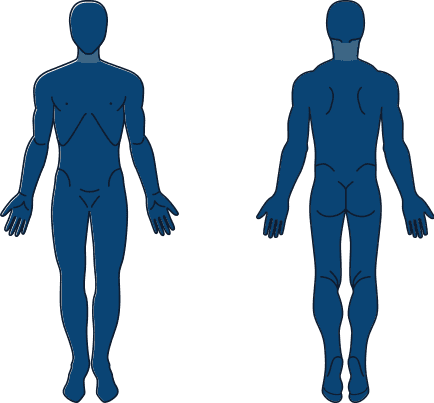What is knee osteoarthritis?
- Osteoarthritis is the degenerative breakdown of the smooth, firm tissue that lines the ends of the bones in the joints.
- This can happen in any joint but is very common in the knee.
What are some of the typical causes of knee osteoarthritis?
- The exact cause of osteoarthritis is unknown, however it is believed to be a combination of genetic, immune, biomechanical, and inflammatory factors.
- Previous knee injuries (ligament damage, fractures, cartilage damage) all lead to an increased risk of developing osteoarthritis.
What are the symptoms of knee osteoarthritis?
- Joint pain, joint stiffness, swelling, start up pain (upon rising), symptoms worsen at the end of the day and or with weather changes, crepitus (crackling/popping sensation) in knee.
What are some initial treatments?
- Heat, ice, compression, avoiding high impact activities, anti-inflammatories are some initial treatments.
What is an anterior cruciate ligament (ACL) injury?
- The anterior cruciate ligament is the ligament that originates off of the femur (thigh bone) and inserts on the tibia (lower leg bone) in the center of the knee joint.
- This ligament is responsible for preventing the tibia from sliding forward and twisting while the knee is bent, thereby providing stability for the knee when turning or planting.
- A sprain or tear of this ligament
What are some of the typical causes of an ACL injury?
- Traumatic impacts
- Sudden cutting/pivoting movements
What are the symptoms of an ACL injury?
- Pain, swelling, knee instability
What are some initial treatments?
- Rest, Ice, Compression, Elevation. This is a condition that should be evaluated by a healthcare professional.
What is a medial collateral ligament (MCL) sprain?
- The medial collateral ligament is the ligament that originates off the medial (inner) side of the femur and attaches to the inner side of the tibia.
- Sprains of this ligament are classified into three grades.
- Grade 1 – Ligaments is not stretched or mildly stretched & painful
- Grade 2 – Ligament is moderately stretched and painful
- Grade 3 – Ligament is torn and not functional
What are some of the typical causes of an MCL sprain?
- MCL sprains are caused by forces that cause the knee to bend sideways towards the other knee.
What are the symptoms of an MCL sprain?
- Pain, swelling, knee instability.
What are some initial treatments?
- Rest, Ice, bracing, anti-inflammatories. This is a condition that should be evaluated by a healthcare professional.
What is patellofemoral syndrome?
- Patellofemoral syndrome is one of the terms given to describe pain behind the kneecap. Other names include runner’s knee, chondromalacia, and patellar malalignment.
What are some of the typical causes of patellofemoral syndrome?
- Patellofemoral syndrome is an overuse injury caused by repetitive running, jumping, cycling, and other athletic or recreational activities that load the knees.
- There are several biomechanical factors that increase the risk of developing patellofemoral syndrome including wide hips, being knock-kneed, weak gluteal muscles, and flat feet or collapsing arches.
What are the symptoms of patellofemoral syndrome?
- Pain behind the knee-cap that worsens with activity.
What are some initial treatments?
- Rest, Ice, Anti-inflammatories, knee bracing, physical therapy.
What is patellar tendinopathy?
- Patellar tendinopathy is a condition in which repetitive use of the muscles acting on the knee results in micro-tears and or inflammation of the tendon connecting the patella to the tibia.
What are some of the typical causes of patellar tendinopathy?
- Repetitive activities such as jumping running, bicycling
What are the symptoms of patellar tendinopathy?
- Pain in the front of the knee, worsened with activity.
What are some initial treatments?
- Rest, ice, anti-inflammatories, strapping/bracing, shoe inserts.
What is prepatellar bursitis?
- A bursa is a fluid filled sac that acts as a cushion between bones, ligaments, tendons, and the skin.
- Bursitis is an irritation and or inflammation of the bursa that causes it to have increased amounts of fluid.
- The prepatellar bursa is located just in front of the patella.
What are some of the typical causes of prepatellar bursitis?
- Prepatellar bursitis is typically caused by increased friction or pressure over the kneecap, as well as overuse.
What are the symptoms of prepatellar bursitis?
- Anterior knee pain, anterior swelling.
What are some initial treatments?
- Rest, Ice, Compression, Anti-inflammatory. The bursa may need to be drained by a healthcare professional.
